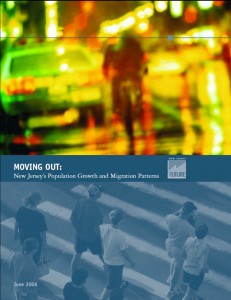Moving Out: New Jersey’s Population Growth and Migration Patterns
Recent Census figures confirm that New Jersey’s population growth, until recently a standout in the largely stagnant Northeast, has begun to slow. In fact, without the influx of international immigrants, New Jersey’s population growth rate between 2000 and 2005 would have been an anemic 0.3 percent, as opposed to the actual rate of 3.6 percent. Net domestic out-migration from New Jersey to other states nearly cancels out the natural rate of population increase.
The absence of population growth by no means implies that a state’s land development will come to a halt, however. Plenty of slow-growth states continue to convert new land to urban uses at a brisk pace: consider the 46 percent increase in developed land in metropolitan Chicago, when the population grew only four percent in the decades 1970 – 1990. Or the 33 percent swell in developed land in metropolitan Cleveland where the population fell by 8 percent in the same time.
In New Jersey, you’d never guess from the proliferation of new construction, especially in the central counties, that our population has grown by only about 12 percent in the 15 years since 1990. Here as in other states, land development and the expansion of the urban frontier are primarily due not to the absorption of new residents, but to the spreading out of existing ones.
County-to-county migration patterns from the 2000 Census confirm this phenomenon, revealing a broad pattern of outward migration from more-urbanized areas to less-urbanized areas, starting in the cities and proceeding out through successive rings of suburbs. The dominant move is always away from New York and Philadelphia, with some out-migrants bypassing one or more of the intermediate steps. Each ring of suburbs welcomes new migrants from closer-in places, while losing migrants to less-developed areas.
The ultimate result is large influxes of people into New Jersey’s exurban counties, and especially into counties in eastern Pennsylvania (the new suburban frontier) – while the urban-core counties lose people to the suburbs. The overflow of north Jersey suburban migration into the counties of eastern Pennsylvania is so pronounced, in fact, that the Pocono counties of Pike and Monroe were the first- and third-fastest growing counties in the entire northeastern United States in the 1990s, and rank first and second so far in the 2000s. In many exurban New Jersey counties, in-migrants from elsewhere in New Jersey account for a substantial share of overall population growth. Out-migration from the urban-core counties is clearly the source of much of the population growth in counties elsewhere in New Jersey.
Outward urban expansion is not necessarily a problem in and of itself. But new development in recent decades has taken a decidedly less-dense, more land-hungry form, with the result that new growth between 1986 and 1995 consumed land at more than double the per-capita acreage of development already on the ground in 1986. And lower densities produce longer distances between destinations, often forcing out-migrants to commute great distances back into the older urban counties for their jobs, adding to traffic woes. New Jersey may be exporting its housing problem to Pennsylvania, with high home values and property taxes chasing home-buyers across the Delaware, but it is importing a traffic problem in exchange. Those commuters are all using New Jersey’s roads to get to work.
Many factors influence the decision to change residences, but usually the primary reason is related to housing – a desire for newer or more affordable housing or for a different type or size of housing unit. The built-out nature of the older, urban counties means that the supply of housing units of all types is constrained, which pushes up prices and forces many buyers to look farther out into the suburban fringe. This is especially true for buyers or renters seeking new construction. Rising property tax rates in older communities also help chase people to outlying suburbs. The lack of housing variety in much of exurban northern New Jersey pushes many homebuyers on into eastern Pennsylvania.
The location of jobs is also a major factor enabling outward migration. As jobs decentralize into the suburbs, many workers take this as a cue to move their residence even farther out into the exurbs, especially if they are having a hard time finding or keeping affordable housing near where their job is now located.
In short, it is not just demographics that determine our landscape or the prosperity of our communities, but also our land use policies. Policies that favor re-investment in and strengthening of today’s communities over sprawling development can help New Jersey ride population growth – or slowdown – into an era of unprecedented prosperity.
Download report:
Moving Out: New Jersey’s Population Growth and Migration Patterns (PDF)












